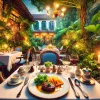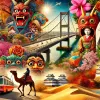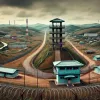Hey everyone, Mark here! I've just returned from an incredible journey through Northeast China, and I'm buzzing to share my experiences exploring two truly remarkable historical sites: Zhang's Marshal's Mansion and the Shenyang Palace. As an American backpacker with a passion for Asian history and culture, these locations completely blew me away. If you’re planning a trip to Asia and are interested in history, then these are absolute must-sees! Let me take you on a whirlwind tour.
Zhang's Marshal's Mansion: A Glimpse into Northeast China's History
The Zhang's Marshal's Mansion, also known as the Da Shuai Fu (大帥府) or Shao Shuai Fu (少帥府), is a breathtaking complex spanning 53,000 square meters. This wasn't just a home; it served as the nerve center of Northeast China's military and political landscape, the residence of the powerful warlord Zhang Zuolin (張作霖) and his son, the famed Zhang Xueliang (張學良). Imagine the power, the intrigue, and the sheer weight of history that permeates these walls!
Construction began in 1914, blending traditional Chinese architecture with then-novel Western influences, reflecting the evolving tastes of the wealthy elite at the time. The mansion consists of three main courtyards and two smaller ones, a testament to the family's wealth and influence. I personally loved the courtyard style; it gave me a strong sense of community, a feeling of families living together in harmony. This is something that’s quite rare in modern Western living.
The intricate carvings and stunning architecture are truly captivating. The East Courtyard's charming little "Qinglou" (小青樓), a Chinese-style building, was specifically built for Zhang Zuolin's favorite wife, Mrs. Shou. The larger, Western-style "Da Qinglou" (大青樓), with its Roman-inspired design, once served as both office and family residence.
The Impact of the Mukden Incident
The mansion is intrinsically linked to the pivotal Mukden Incident (皇姑屯事件) of 1928. The assassination of Zhang Zuolin by the Japanese Kwantung Army, orchestrated by blowing up a section of the South Manchuria Railway, was a turning point that plunged Northeast China into war.
The incident is a dark stain on history, representing an act of blatant aggression by Japan. I found the thought of this pivotal historical event occurring in this very place both sobering and fascinating. It makes the whole site feel profoundly charged with history. It made me think, if Zhang Zuolin had lived, what would have happened? Would the Japanese invasion have been averted, or would another conflict have been unavoidable?
Zhang Zuolin: From Humble Beginnings to Warlord
Zhang Zuolin's life story is remarkable. Born in 1875, he rose from humble beginnings in a small village to become a powerful figure, a "Northeast King" who commanded respect, even from his enemies. He initially fought alongside the Qing Dynasty against bandits and successfully suppressed Mongolian unrest. His military prowess and political acumen propelled him to the height of power, holding significant sway over China’s destiny. His strategic intelligence and deft maneuvers made him a feared but also admired figure. I was fascinated by his resilience and tenacity. Even his adversaries had grudging respect for him, considering him a true "man."
Despite his power, he consistently resisted Japanese influence, refusing to sign treaties that would have undermined China's sovereignty. His eventual assassination was, therefore, a strategic move by the Japanese to destabilize the region. It’s a powerful reminder of the complexities of power and the high stakes of international relations.
The Legacy of Zhang Xueliang
The death of Zhang Zuolin left his son, Zhang Xueliang, to inherit a turbulent legacy. While he initially tried to consolidate power, the Mukden Incident of 1931, the infamous start of the Second Sino-Japanese War, threw him into a desperate situation. The pressure exerted by Chiang Kai-shek's policy of prioritizing domestic stability over immediate resistance to Japan, combined with Zhang's own political missteps, led to the loss of Manchuria. The subsequent Xi'an Incident, where Zhang detained Chiang to pressure him into a full-scale resistance against Japan, remains a controversial chapter in Chinese history, demonstrating both his patriotism and his flawed judgment.
Shenyang Palace: A Glimpse into Manchu Dynasty Splendor
After visiting Zhang’s Marshal’s Mansion, I headed to the Shenyang Palace, also known as the Mukden Palace or the Shengjing Palace. This is another incredibly significant historical site. Unlike the Beijing Forbidden City, the Shenyang Palace offers a unique perspective into the Manchu culture and the early years of the Qing Dynasty.
Here's a comparison of the two palaces:
| Feature | Shenyang Palace | Beijing Palace (Forbidden City) |
|---|---|---|
| Dynasty | Qing Dynasty (Early) | Ming and Qing Dynasties |
| Culture | Primarily Manchu | Primarily Han |
| Size | Smaller | Larger |
| Architectural Style | Emphasis on Manchu elements | More Han Chinese elements |
| Rulers | Nurhaci, Hong Taiji, and Fulin | Several Ming and Qing emperors |
| Construction Year | 1625 | 1420 |
The layout of the Shenyang Palace is divided into three sections: the East, Middle, and West roads. The East Road, built during Nurhaci's reign, features structures reflecting the nomadic lifestyle of the Manchus. The Middle Road, with its impressive grand hall, commemorates Hong Taiji's ascension to the throne. The West Road, added later, has a very different feel. I felt a powerful sense of history walking these paths. The whole palace is adorned with exquisite yellow glazed tiles and incredibly detailed carvings.
The palace is surprisingly smaller than the Beijing Forbidden City, yet its intricate design and profound cultural significance make it just as impressive. The unique architectural features, showcasing the Manchu heritage with its unmistakable style, are simply captivating. I personally preferred the Shenyang Palace due to its more intense concentration of Manchu cultural elements, which made it feel very authentic.







